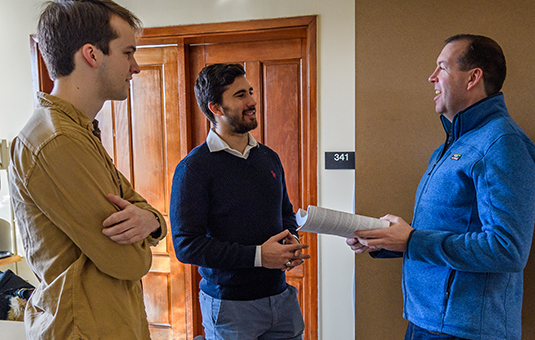Computer Science
Observation of two families of folding pathways of BBL
Document Type
Article
Abstract
BBL is an independent folding domain of a large multienzyme complex, 2-oxoglutarate dehydrogenase. The folding mechanism of BBL is under debate between the views of noncooperative downhill-type and classical two-state. Extensive replica exchange molecular dynamics simulations of BBL in explicit solvent have shown some non-two-state behaviors despite no definitive evidence of downhill folding. In this work, we postprocess the replica exchange data using our roadmapbased MaxFlux reaction path algorithm to reveal atomically detailed folding pathways. A connected graph is used to organize and visualize the folding pathways initiated from random coils. High structural and transition heterogeneity is seen in the early stage of folding. Two main parallel folding pathways emerge in the later stage; one path shows that tertiary contact and helix formation develop at different stages of folding, whereas the other path exhibits concurrence of secondary and tertiary structure formation to some extent. Because the native state of BBL is sensitive to experimental conditions, we speculate that the relative predominance of the two pathways may vary with the protein construct and solvent conditions, possibly leading to the seeming discrepancy of experimental results. Our roadmap-based reaction path algorithm is a general tool to extract path information from replica exchange. © 2011 by the Biophysical Society.
Publication Title
Biophysical Journal
Publication Date
2011
Volume
100
Issue
10
First Page
2457
Last Page
2465
ISSN
0006-3495
DOI
10.1016/j.bpj.2011.03.058
Repository Citation
Fan, Jue; Duan, Mojie; Li, Da Wei; Wu, Hao; Yang, Haijun; Han, Li; and Huo, Shuanghong, "Observation of two families of folding pathways of BBL" (2011). Computer Science. 190.
https://commons.clarku.edu/faculty_computer_sciences/190
APA Citation
Fan, J., Duan, M., Li, D. W., Wu, H., Yang, H., Han, L., & Huo, S. (2011). Observation of two families of folding pathways of BBL. Biophysical journal, 100(10), 2457-2465.
Copyright Conditions
Fan, J., Duan, M., Li, D. W., Wu, H., Yang, H., Han, L., & Huo, S. (2011). Observation of two families of folding pathways of BBL. Biophysical journal, 100(10), 2457-2465.



